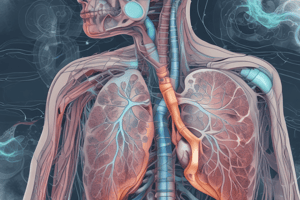Podcast
Questions and Answers
What characterizes asthma as a reversible obstructive lung disease?
What characterizes asthma as a reversible obstructive lung disease?
- Permanent lung tissue damage
- Chronic airway inflammation and mucosal edema (correct)
- Increased airflow into the alveoli
- Complete blockage of airflow into the lungs
Which of the following is NOT a predisposing factor for asthma?
Which of the following is NOT a predisposing factor for asthma?
- Exposure to allergens
- Female gender
- Atopy
- Age over 40 (correct)
What occurs during obstructive lung disease regarding gas exchange?
What occurs during obstructive lung disease regarding gas exchange?
- Increased gas exchange due to better airflow
- Normal gas exchange despite reduced airflow
- Decreased gas exchange due to blocked airflow (correct)
- Enhanced oxygen uptake in the alveoli
Which condition is categorized under restrictive lung disease?
Which condition is categorized under restrictive lung disease?
What impact do mediators released by mast cells have during an inflammatory response in asthma?
What impact do mediators released by mast cells have during an inflammatory response in asthma?
Which of the following is a common symptom of asthma?
Which of the following is a common symptom of asthma?
During what condition is airflow limited due to lung stiffness rather than blockage?
During what condition is airflow limited due to lung stiffness rather than blockage?
What is one of the known risk factors for asthma exacerbations?
What is one of the known risk factors for asthma exacerbations?
What is a significant late sign of hypoxemia in patients experiencing acute asthma symptoms?
What is a significant late sign of hypoxemia in patients experiencing acute asthma symptoms?
Which diagnostic test is most indicative of rapid respirations during an acute asthma episode?
Which diagnostic test is most indicative of rapid respirations during an acute asthma episode?
Which treatment is typically administered to manage hypoxic patients during asthma attacks?
Which treatment is typically administered to manage hypoxic patients during asthma attacks?
What is one of the common pharmacological treatments used for quick relief of asthma symptoms?
What is one of the common pharmacological treatments used for quick relief of asthma symptoms?
What should be monitored frequently in patients experiencing severe asthma attacks?
What should be monitored frequently in patients experiencing severe asthma attacks?
In acute exacerbations, which intervention is used to confirm the absence of acidosis during monitoring?
In acute exacerbations, which intervention is used to confirm the absence of acidosis during monitoring?
Which of the following is a potential life-threatening condition associated with asthma?
Which of the following is a potential life-threatening condition associated with asthma?
What is an expected finding in laboratory tests during acute asthma episodes?
What is an expected finding in laboratory tests during acute asthma episodes?
Flashcards are hidden until you start studying
Study Notes
Airflow in Healthy Lungs
- Inhaled air travels through the pharynx, trachea, bronchi, bronchioles, and ultimately reaches the alveoli.
- Alveoli are the primary sites for gas exchange.
Obstructive Lung Disease
- Characterized by reduced gas exchange due to impaired airflow in and out of the alveoli.
- Conditions causing obstruction include:
- Asthma
- Bronchiectasis
- Chronic Bronchitis
- Emphysema
- Foreign Body Obstruction
Restrictive Lung Disease
- Results in limited airflow as the lungs cannot expand fully.
- Common causes include:
- Pulmonary stiffness or muscle rigidity
- Pneumonia
- Pleurisy
- Pleural Effusion
- Pneumothorax
- Respiratory depression from CNS issues
- Acute Respiratory Distress Syndrome (ARDS)
- Sudden Infant Death Syndrome (SIDS)
Asthma
- Involves chronic airway inflammation leading to hyperresponsiveness, mucosal edema, and increased mucus production.
- Initially reversible, can progress to irreversible with worsening pathology.
- Predisposing factors include atopy and female gender.
- Causal factors involve exposure to allergens and occupational sensitizers.
Contributing Factors of Asthma
- Respiratory infections
- Air pollution
- Active and passive smoking
- Other factors: diet, small birth size
Risk Factors for Asthma Exacerbations
- Allergens
- Respiratory infections
- Exercise and hyperventilation
- Weather changes
- Sulfur dioxide exposure
- Food or medication sensitivities
Symptoms of Asthma
- Wheezing
- Coughing, with or without mucus
- Dyspnea (difficulty breathing)
- Chest tightness
Inflammatory Response in Asthma
- Mast cells release mediators like histamine and leukotrienes, perpetuating inflammation.
- Results in increased blood flow, vasoconstriction, fluid leakage, increased mucous secretion, and bronchoconstriction.
Clinical Manifestations of Asthma
- Symptoms may worsen progressively or occur abruptly.
- Notable symptoms include:
- Cough
- Dyspnea from constricted airways
- Wheezing during expiration, potentially progressing to inspiration
- Tachycardia
- Diaphoresis
- Cyanosis indicates hypoxemia (late sign).
- Status Asthmaticus represents a life-threatening condition.
Diagnostics for Asthma
- Medical history and physical examination focusing on familial and environmental factors.
- Laboratory tests may reveal:
- Eosinophilia during acute episodes
- Elevated serum IgE with allergic triggers
- Arterial blood gas analysis indicating hypocapnia from rapid breathing, leading to respiratory alkalosis.
- Pulse oximetry may show decreased oxygen saturation.
Medical Management of Asthma
- Administering oxygen for hypoxia.
- Monitoring blood gases during severe attacks to prevent acidosis.
- Pulse oximetry for acutely ill patients.
- Treating underlying allergic reactions.
- Using smooth muscle relaxants and steroids (inhaled/systemic).
- Spirometry for assessing treatment efficacy.
Pharmacologic Management of Asthma
- Short-acting beta2-adrenergic agonists (SABA): e.g., albuterol; they relax smooth muscles.
- Dosage:
- Nebulized: 2.5 – 5 mg every 20 minutes for 3 doses.
- MDI: 4 – 6 puffs every 20 minutes for 3 doses.
- Dosage:
- Anticholinergics: Inhibit muscarinic receptors to reduce vagal tone in the airways; e.g., Ipratropium.
Studying That Suits You
Use AI to generate personalized quizzes and flashcards to suit your learning preferences.



